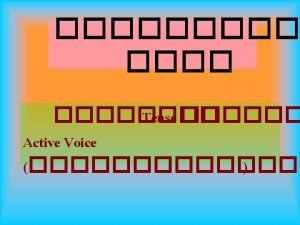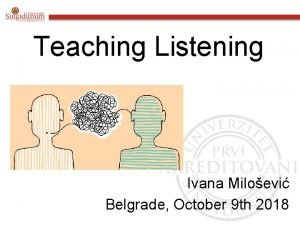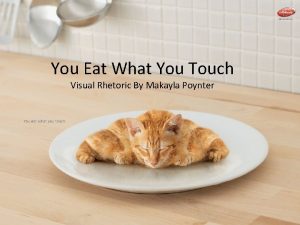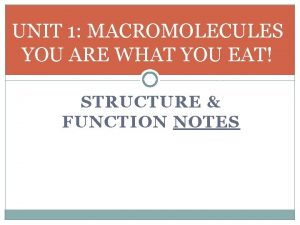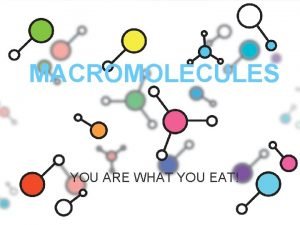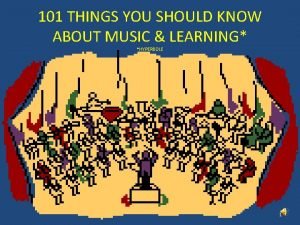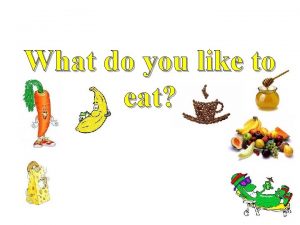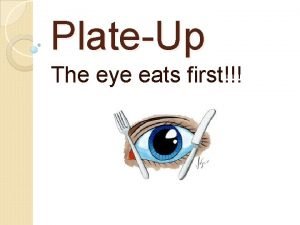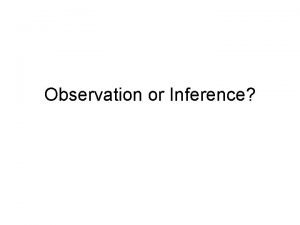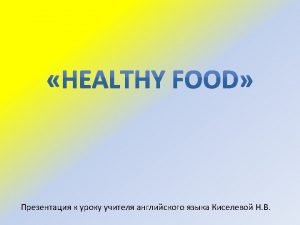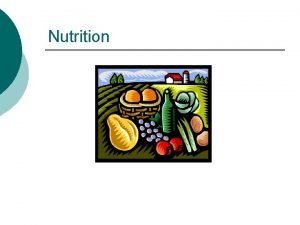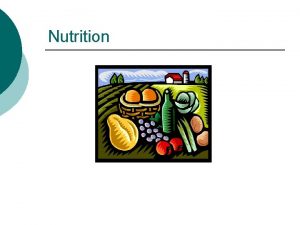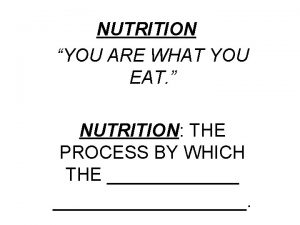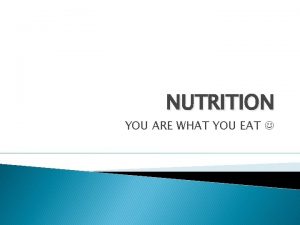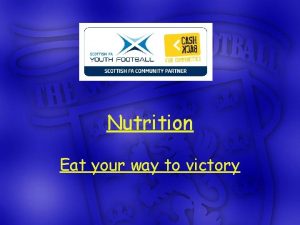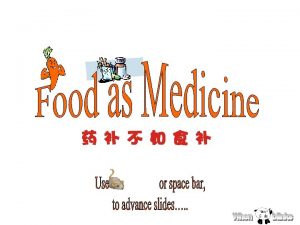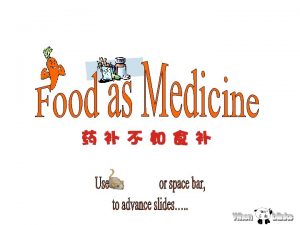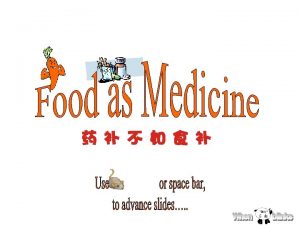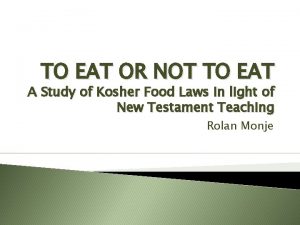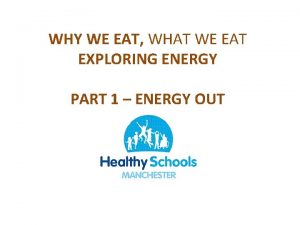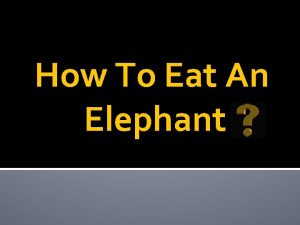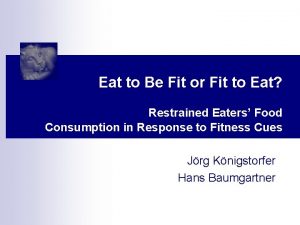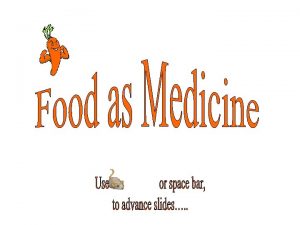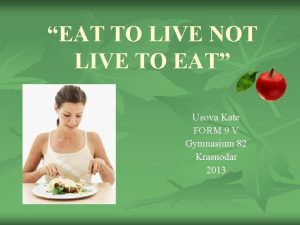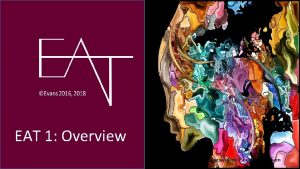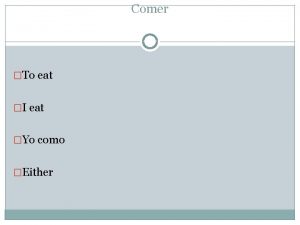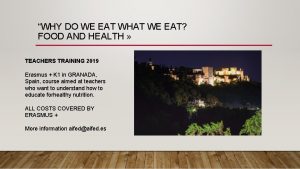NUTRITION You are what you eat Nutrition All





















- Slides: 21

NUTRITION You are what you eat!

Nutrition All body processes related to food: growth, development and health

Good and Bad • Optimum function • Feel good • Look good • More successful • • Hypertension Atherosclerosis Osteoporosis Malnutrition

Seven Basic Components • • Proteins Carbohydrates Fats (Lipids) Water • Fiber • Vitamins • Minerals

Calories • Protein: 1 gram = 4 calories • Carbohydrate: 1 gram = 4 calories • Fat: 1 gram = 9 calories

Proteins: 20% • Build & repair cells & tissues • Made from amino acids • 20 necessary, 9 essential (complete)

Proteins • Amino Acids • Provide long(22) – 9 essential term energy: 4 calories per gm • Complete: animal sources • Basic body • Incomplete: components vegetable sources

Carbohydrates: 50 -60% • 2/3 of daily energy needs • Simple: sugars • Complex: grains, fruits, etc.

Carbohydrates • Major source of energy – 4 calories per gm • Found in cheaper food sources • Provide fiber

Fat: 30% • Concentrated energy • Transport Vit A, D, E, K • Saturated – solid • Unsaturated liquid

Fats/Lipids • Concentrated energy – 9 calories per gm • Fat soluble vitamins: a, d, e, k • Flavor source • Saturated: hard – bad • Unsaturated: soft - good

HDL vs LDL • Lipoproteins that carry cholesterol and triglycerides in the blood • HDL – good: clean arteries by taking lipids to liver for elimination • LDL – bad: primary risk factor for heart attack (clog arteries)

Vitamins • Needed for essential functions • Water soluble • Fat soluble

Minerals • Regulate body fluids • Growth • Build tissues

Water • No calories • 65% of body • Needed for fluid balance, as solvent, to aid digestion, & remove waste

Water • Essential for digestion • Plasma • 6 – 8 glasses • Reabsorption

Water Problems • Dehydration – severe loss of water (fever, vomiting, diarrhea) • Edema – severe retention of water (kidney disease, heart failure) • Pitting edema – leaves indentation on body part (1 – 4 plus)

Food Pyramid • Visual picture • Food groups • Number of servings from each

Modified Diets • Allergies: Common allergens are wheat, milk, eggs & chocolate. • Anemia: Need iron. Found in liver, egg yolks, dark green veges, beans, fortified foods.

Modified Diets • Cancer: Need calories & vitamins A, C, D & E. • Diabetes: Modifies blood sugar levels. Food exchanges divided into 6 areas. • Heart disease: Lower cholesterol, triglycerides and calories.

Processes • Digestion – change food physically • Absorption – move from digestive to circulatory systems • Metabolism – change food to energy in cells
 Insidan region jh
Insidan region jh I eat, you eat, he eats.
I eat, you eat, he eats. I would rather eat potatoes than to eat rice answer
I would rather eat potatoes than to eat rice answer People buy me to eat but never eat me what am i
People buy me to eat but never eat me what am i Eat meals that are nutritious agree or disagree
Eat meals that are nutritious agree or disagree Tell me what you eat and i shall tell you what you are
Tell me what you eat and i shall tell you what you are Opposite rays
Opposite rays You eat what you touch
You eat what you touch Victory in jesus images
Victory in jesus images Macromolecules you are what you eat
Macromolecules you are what you eat Biological molecules you are what you eat
Biological molecules you are what you eat Objective of digestive system
Objective of digestive system Every good boy does fine all cows eat grass
Every good boy does fine all cows eat grass You are my all in all images
You are my all in all images All of you is more than enough for all of me
All of you is more than enough for all of me Why does atticus ask about the doctor
Why does atticus ask about the doctor What do you like to eat
What do you like to eat The eyes eat first
The eyes eat first Sewer lice
Sewer lice How to answer what's your favourite food
How to answer what's your favourite food You eat with your eyes first
You eat with your eyes first What do you like to eat
What do you like to eat

